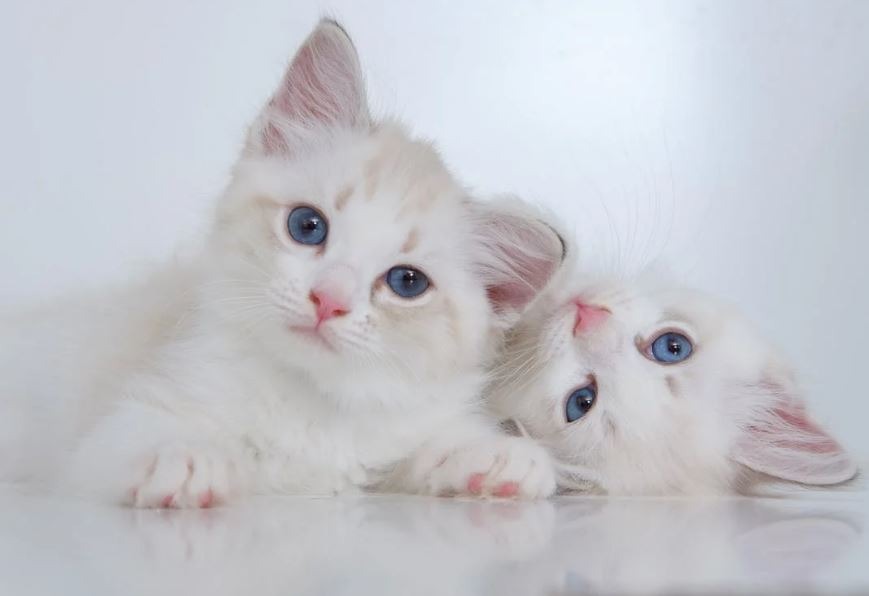Dwarf, miniature, and teacup cats are the three types of small breed cats. There are subtle differences between them, but they all share the trait of being extremely small when fully grown. People looking for miniature cats should be aware that not all small cats are true miniatures. Cats typically range in size from 5 to 12 lbs. The cat breeds at the lower end of the scale are not necessarily miniatures but may simply be runts sold as miniatures.
Miniature cats are typically one-third to one-half the size of regular-sized cats of the same breed. A true Teacup Cat, on the other hand, is born with genetic dwarfism that causes the cat to be proportionally small all over, rather than just the legs. Let’s look at some of the top smallest cat breeds that look like a cuddly kitten forever:
1. Singapura Cat
The world’s smallest cat breed is the Singapura, it is about half the size of the average cat but has a big presence. This tiny breed is active and affectionate, and it is constantly curious about what everyone is doing. The friendly breed is ideal for families with children because Singapura does not like being left alone. They are sociable and can live peacefully with other pets in a household.
This adorable little cat has a very short and fine coat that is moderately stocky and muscular. A fully grown female weighs 1.8 kilograms, while a fully grown male weighs 2.7 kilograms. The breed’s characteristics include large, slightly pointed, deep cupped ears and large almond-shaped eyes. In fact, it is listed as one of the 8 cat breeds with big distinctive eyes and is considered a pricey pet. The tail is slim, slightly shorter than the body’s length, and has a blunt tip.
2. Devon Rex Cat
The Devon Rex is an intelligent, tall-eared, short-haired cat breed that originated in England in the late 1950s. They are distinguished by their slender bodies, wavy coats, and large ears. This breed of cat can learn difficult tricks but can be difficult to motivate. Their ears are unusually large and slightly rounded, set low on the sides of their broad heads, their eyes are large, and their noses are slightly upturned. Unlike most cats, their whiskers are very short and frequently curled to the point where it appears that they have no whiskers. Their body type is noticeably light. Their long, strong legs are ideal for long leaps, and their toes are unusually large.
3. Burmese Cat
Burmese is a small to medium-sized breed, weighing 4 to 6 kilograms, but they are well-built, muscular cats that should feel heavy for their size when held giving “a brick wrapped in silk” feels. The American Burmese is a stockier cat with a much broader head, round eyes, and a noticeably shorter, flattened muzzle. The ears are wider at the base, the legs and tail are medium-length, and proportionate to the body, with rounded paws. The Burmese cat breed is outgoing and extremely patient with children, known to follow them around the house, and adores affection. They enjoy using their intelligence to solve pet puzzles and learn new tricks.
4. Siamese cat
Siamese cats, despite their average size, are surprisingly light. The breed is the supermodel of the cat world, being long, lean, and intelligent. They’re not lazy and thrive on a variety of activities, such as fetch, walking on a leash, and pawing at faucets until they turn on. Siamese cats are known to be extremely vocal, in fact, they are listed as one of the cat breeds with strong vocal expressions adding more to their distinct characteristics. Siamese cats are known for their social nature and are typically very affectionate and intelligent. They frequently form strong bonds with a single person. They have a distinct meow that has been compared to human baby cries, and they are persistent in demanding attention. Even as adults, these cats are typically active and playful.
5. American Curl Cat
The American curl is a newer breed that got its start in 1981 when a stray with strange ears was found and gave birth to kittens with the same strange ears, according to The International Cat Association (TICA). The breed’s ears naturally tilt back due to a harmless genetic mutation, exposing the furry under-flap and making their ears appear tiny. This tiny breed usually coos rather than meows to get your attention and is loving and playful, with a kittenish curiosity that lasts into old age. The American curl has a sharp intellect and is known for its ability to turn doorknobs and open cabinets.
6. Munchkin Cat
The Munchkin is a relatively new breed of cat distinguished by its extremely short legs caused by a genetic mutation. It is believed that the Munchkin was the first dwarf cat breed. Due to their frequent use as outcrosses, Munchkins have characteristics similar to normal domestic cats. It is small to a medium-sized cat with a medium-plush coat and a medium-sized body. Male Munchkins typically weigh 2.7 to 4.1 kg and are larger than female Munchkins, which usually weigh 1.8 and 3.6 kg. The back legs can be slightly longer than the front legs, resulting in a slight rise from the shoulder to the rump. The Munchkin’s legs may be slightly shorter.
7. Somali Cat
Somalis are known for their bushy tails, large almond eyes, and large pointed ears, earning them the nickname “Fox Cat.” Their ticked coats, which contain between four and twenty colors on each hair, are very fine in texture, making them softer to the touch than other cat breeds. The cat itself is of medium size. The typical or ruddy Somali cat is golden brown with black ticking. There are 28 Somali colors in total, though some organizations only accept a subset of these. Most clubs accept usual/ruddy silver, sorrel/red silver, blue silver, and fawn silver as well. Some registries may accept chocolate, lilac, red, cream, usual-tortie, sorrel-tortie, blue-tortie, fawn-tortie, chocolate-tortie, lilac-tortie, and silver variants of these colors.
8. LaPerm Cat
The LaPerm is a cat of moderation, with no extremes, and remains true to its original type. It does, however, have a distinctive coat. The breed standard specifies a muscular foreign-type body that is medium in size and has longish legs and a neck. The head is shaped like a modified wedge, with rounded contours and a muzzle that is slightly wider than the wedge. The straight nose leads to a gap between the eyes and a flattish forehead in profile. LaPerms’ have wide noses, flared ears, and medium-sized almond-shaped eyes.
9. Turkish Angora Cat
Turkish Angora cats are an ancient, natural breed of cat that originated in central Anatolia, modern-day Turkey, in the Ankara region. The breed was first documented in the 17th century. Outside of the United States, the breed is commonly known as the Angora or Ankara cat. Turkish Angoras are active, intelligent, and playful. They form bonds with humans, but they frequently choose a family member to be their constant companion and protector. They try to be “helpful” to their humans in any way they can, and their intelligence can be impressive at times, displaying basic problem-solving skills. Because of their intelligence and desire to interact with humans, they are easily trained.

